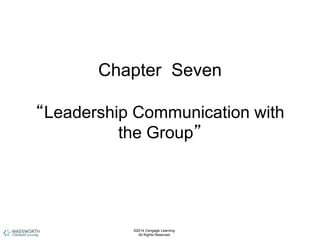Weitere ähnliche Inhalte
Ähnlich wie Chapter 7 Leadership Communication with the Group (20)
Kürzlich hochgeladen (20)
Chapter 7 Leadership Communication with the Group
- 2. Guiding Questions
1. How does the teacher establish
leadership in the encouraging
classroom?
2. Why are guidelines, not rules, important
in the encouraging classroom?
3. How is encouragement more appropriate
than praise?
4. Why is discussing inclusively important?
©2014 Cengage Learning.
All Rights Reserved.
- 3. Guiding Questions
5. How do class meetings build the encouraging
classroom?
6. How does the adult teach friendliness in the
encouraging classroom?
7. Cultural Responsiveness: How do teachers turn
discriminatory remarks made by children into
learning experiences?
8. Family Partnerships: How does leadership
communication with parents build and maintain
partnerships?
©2014 Cengage Learning.
All Rights Reserved.
- 4. After studying this chapter, you should be able to:
• Describe how class meetings sustain an
encouraging classroom.
• Understand how an adult teaches
friendliness in an encouraging classroom.
• Explain how leadership communication
with parents builds and maintains
partnerships.
©2014 Cengage Learning.
All Rights Reserved.
- 5. Establishing Leadership
• Establishing leadership begins the first day
of class, as the teacher introduces the
children to routines and guidelines.
• The teacher should be clear, firm, and
friendly.
• Remember that the children are likely
more anxious than you about the start of
school.
©2014 Cengage Learning.
All Rights Reserved.
- 6. Guidelines vs. Rules
• Rules tend to be stated in negative terms—i.e. “no running
in the classroom”—and have predetermined punishments
for infractions.
– Rules tell children what not to do, not what to do.
– They communicate to children that the teacher expects that they will
be broken.
• Guidelines are stated in positive terms– i.e. “we use words
to solve problems”—and leave room for teacher
professionalism when considering appropriate
consequences.
– Rules tell children what to do.
– Logical consequences can be used, specific to each situation.
• The consequence should be logical to both the teacher and the child
©2014 Cengage Learning.
All Rights Reserved.
- 7. Encouragement vs. Praise
• While praise gives approval of a child’s achievement,
encouragement empowers their efforts—the process of
learning.
– Praise places an emphasis on “winning” or “doing the best”, which
can make children anxious about not living up to the adult’s
expectations.
– Encouragement places the support where it’s most needed, during
the task completion, as accomplishments tend to bring their own
rewards.
• Encouragement can be either private or public.
– Private encouragement, providing the child with a feeling that they
were noticed and appreciated
– Public encouragement, providing a feeling of positive group spirit and
allowing each child to evaluate their own efforts
©2014 Cengage Learning.
All Rights Reserved.
- 8. Discussing Inclusively
• When a teacher keeps an open mind and
ear, instead of focusing on “right” and
“wrong” answers, she welcomes all
perspectives.
• Discussing inclusively creates a respectful
environment for children to share their
understandings, offering opportunities for
pride and acknowledgement instead of
fear of shame.
©2014 Cengage Learning.
All Rights Reserved.
- 9. Class Meetings
• Teachers choose to hold class meetings in order to
establish a sense of belonging within the group, conduct
class business, and solve problems that arise.
• Class guidelines such as these apply:
– Anyone can talk. – Be honest.
– Take turns and listen carefully. – Be kind.
• Teacher might also have personal guidelines for class
meetings:
– Support each child in the expression of his or her views.
– Maintain a positive, caring focus.
– Personal situations may require private remedies.
– Meetings are to solve problems, not create them.
– Build an encouraging community that includes everyone.
©2014 Cengage Learning.
All Rights Reserved.
- 10. Teaching Friendliness
• Strategies for teaching friendliness include:
– Use class meetings and your curriculum to teach
friendliness
• Discuss real situations
• Dramatize using puppets or other props
• Use children’s literature
– Establish a guideline of friendliness such as, “We
cooperate with others in our work and play”
• Actively teach words such as “cooperate”
– Use your leadership to structure small-group experiences
that transcend the usual social circles
• Build experiences of success in diverse small groups
©2014 Cengage Learning.
All Rights Reserved.
- 11. Teaching Friendliness
• When deciding how you will teach friendliness, keep in
mind where young children are at developmentally.
• Young children in Piaget’s preoperational stage of
development have some limitations in their understanding
of social situations:
– developmental egocentrism—difficulty in seeing situations
(and relationships) as others do.
– centering—difficulty in comprehending the complexities of
situations.
– exclusivity—difficulty in understanding that if something
belongs to one grouping, it can also belong to another
©2014 Cengage Learning.
All Rights Reserved.
- 12. Family Partnerships
• Responsibility for communication with parents lies with the teacher.
• Leadership communication can take a variety of forms:
– Written notes
– Electronic communication
– Telephone contacts
– Parent meetings
– Parent-teacher conferences
• For parents to feel comfortable with communications they must feel
comfortable in their relationship with the teacher.
• Communicate about positive things in addition to difficulties, be
sensitive to literacy levels of parents, describe things without making
value judgments.
©2014 Cengage Learning.
All Rights Reserved.

